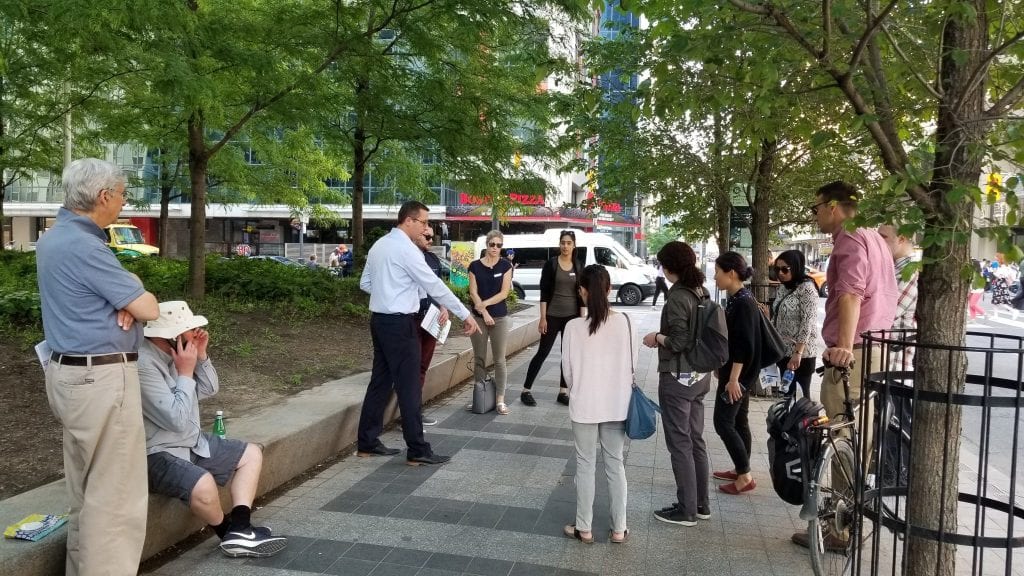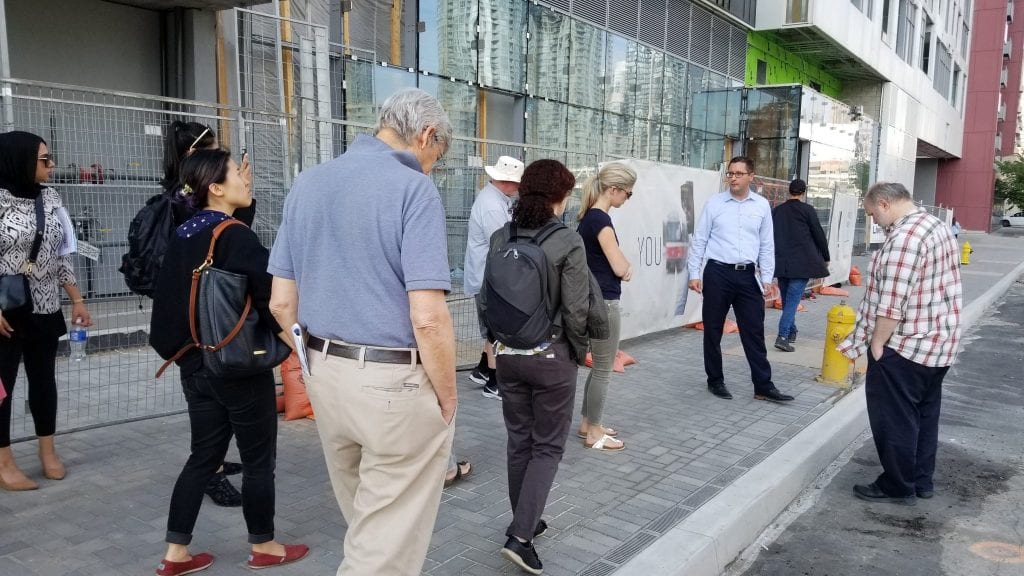At GreenBlue Urban we are constantly committed to engaging a broad range of professionals to share our experience of urban tree pit design and especially the approaches to LID/(SuDS) tree pits in constrained urban environments. Planners hold the key to setting the policy framework that enable us to develop more sustainable and resilient cities and to create a common language when it comes to trees as part of water management in our towns and cities. It was with this in mind that GreenBlue Urban’s Consultant Jeremy Bailey provided a walking tour of the downtown Toronto area that was hosted by Ontario Professional Planner’s Association.

This was a fantastic opportunity for professionals with an abiding interest in the relationship between planning and the provision of green and blue infrastructure. Coming together to see projects using engineered soil cells to both manage root systems and attenuate stormwater. Innovation is critical to developing a standard way of using natural assets such as urban trees to mitigate against flood risk. Toronto like many other North American cities is not immune from flood risk. The 2014 Toronto Emergency Plan notes that “floods are a common and widespread natural hazard across Canada” and many households rely on forward thinking policies and action plans to reduce their vulnerability.

This Walking Tour was part of wider program to engage a multitude of different disciplines with these issues. Participants from across the Greater Toronto Area were able to see the physical locations of the LID tree pits and wider green infrastructure projects which enhances the learning experience.
Quite often we see the theory and the model planning policies that are often associated with green street scenes and downtown areas, but in practice the delivery and aftermath are not always considered. Toronto has an excellent track record of valuing and creating policies to enhance and maintain its urban trees and green infrastructure across the city, but we all know we can achieve more working together and sharing ideas through interdisciplinary collaboration. It was this in mind that GreenBlue Urban wanted to work proactively with the Ontario Professional Planner’s Association so that the walking tour could provide a platform to disseminate knowledge across a wider audience and also facilitate discussion amongst professionals that may not otherwise have taken place.
We can all be forgiven for sometimes working in silos and the walking tour was designed to make that explicit connection between green infrastructure and how we manage water. This is still an area where policy needs to develop to support the wealth of technological innovations out there that are truly multi-functional and can provide soil volume for the trees whilst also being an integral part LID/SuDS design.
For this particular event, Jeremy began the tour at 590 King Street West – a site utilized a Linear Drain supplied by GreenBlue Urban to channel stormwater runoff from the sidewalk into the soil within a suspended pavement system below.

300 Front Street also used a GreenBlue Urban Linear Drain to channel stormwater into a suspended pavement area below. Images from this site compare growth from 2014 to 2019, the difference is quite outstanding!

Union Station was a standard tree planting application that used GreenBlue Urban’s StrataCell system.
Jack Layton Ferry Terminal was one of the first Toronto installations of GreenBlue Urban’s latest soil cell RootSpace. This site is where we ended the tour. It utilizes GreenBlue Urban Linear Drain along with all the ancillary ArborSystem components like RootRain Irrigation/Aeration.

The aim of the event was also to answer some common questions that planners require to adequately assess whether their local policy framework is providing for the long-term health of their green infrastructure and LID schemes and those delivered by developers in and around their cities. For example, how can tree pits manage stormwater from the roadway?
How can we install and monitor these LID tree pit systems across a variety of contexts and at varying scales?
GreenBlue Urban are passionate advocates of using physical site visits to underpin and illustrate the key principles of using uncompacted quality soil in geocellular structures to ensure the long term survival of urban trees in the hard landscape, and this walking tour enabled participants to have a contextual overview of the way these projects connected and enhanced the cityscape. It provided an opportunity to showcase how urban sustainability and resiliency are not achieved discretely but strategically through design. Placemaking and community buy-in is also vital to the success of these high quality schemes. The city is the sum of citizens and these long-term legacy schemes are here to enjoy.
Please contact the GreenBlue team to arrange a walking tour in your city!
